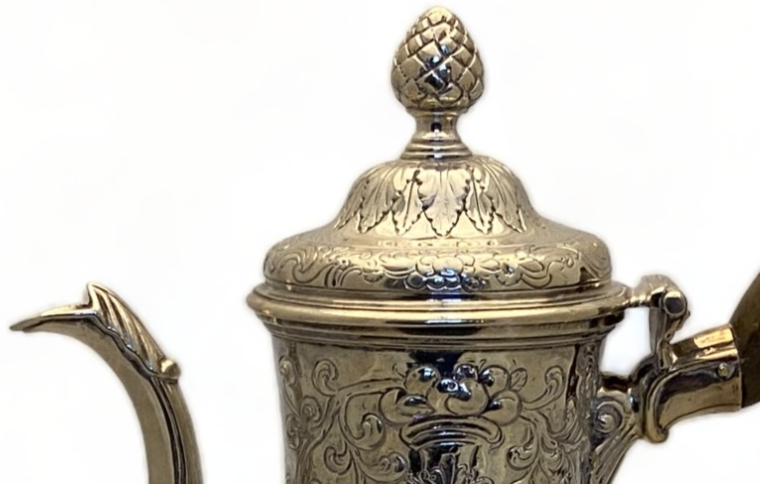A tale of two cities: a brief history of silver in Dublin and Cork
A fine George III silver dish ring, unmarked, circa 1765 | The dish ring was first seen in the 1700s and at the time dining tables were distinguished by their highly polished surface. The ring keeps food warm and also protects the table’s lustre. When not in use the ring with its chased and pierced decoration is an attractive item in itself
A recent auction held at The Pedestal featured an interesting group of Irish silver dating from the 18th and 19th centuries created by silversmiths working in both Dublin and Cork.
From the mid-17th century Dublin and Cork both underwent significant expansion and with this demand for domestic silver followed. Bands of skilled silversmiths were established to serve this new tier of consumers and they thrived into the next century and beyond, the range and the quality of their output have not been surpassed since then. In the British Isles of the 18th century Dublin was the second city to London and silver designs there matched those seen in London within a few years.
Here we explore the jostling between Ireland’s two major silver manufacturing centres.
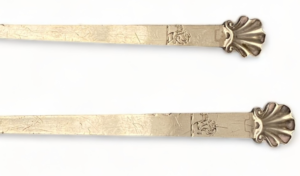
Two 18th century Irish graduated silver shell end meat skewers by Richard Williams, Dublin, circa 1770 | The shell motif was frequently seen in the last decades of the 18th century. In 1779, following the theft of the silver plate from St. Patrick’s Cathedral, Dublin, Richard Williams was commissioned to create a new set
In 1637 under the Royal Charter of Charles I the Company of Goldsmiths of Dublin was established, whereas across the Irish Sea close to 300 years earlier in 1327 and under Edward III’s Royal Charter ‘The Wardens and Commonality of the Mystery of Goldsmiths in the City of London’ had been incorporated. Gold and silversmithing had of course existed in Ireland long before these 17th century developments in Dublin and can be traced back to pre-historic times, as early as 1800BC. Silver manufacture flourished following the introduction of Christianity to Ireland in the 5th century, and also during the Medieval period after the Anglo-Norman invasion of 1169. A company of goldsmiths in Dublin was referenced in 1498 when it was represented along with other city guilds during that year’s Corpus Christi events. IN 1557 the company produced evidence the Dublin City Council to the effect that they were an ancient incorporation whose charter had been burnt in error. It was granted re-incorporation on this occasion but it came with terms, ‘none shall be admitted to the fraternity without he be of English name and blood of honest conversation and also free citizen of this city’. A definite mark of assay was not enforced until 1605 in Dublin in the light of fraudulent and ‘indirect and sinister’ silver dealing which had been seen in the preceding years. The marks of a lion, harp and castle were struck in an effort to deal with dishonest workmanship, with the resolution that the silver should be ‘as pure silver as the standard silver coin now current in this Kingdom’.
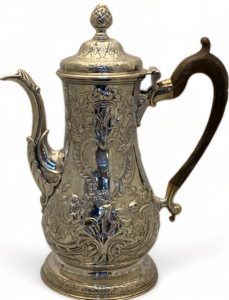
A George III Irish Provincial silver repousse coffee pot, John Nicholson, Cork, circa 1770 | Nicholson is first mentioned in 1756 at 70, Grand Parade, Cork and in 1769 started a sword cutting business. He worked as a Valuator in the Holy Trinity parish from 1783 and duly registered his business in Dublin under the provisions of the 1783 Act
The thorough stipulations of 1637 regulated the trade in silver in all of Ireland, with the King’s stamp, the harp crowned, indicating that the silver had been assayed. The reality was that not much early silver was assayed, other than that made in Dublin, and many items which are clearly from the 17th and 18th centuries do not have a mark or only bear the mark of a provincial town. The Dublin Charter also included an oath of allegiance to the sovereign which might have excluded a number of Irish goldsmiths. Although the Charter ordered country makers to bring their silver to Dublin for assay the early books of the company indicate that not all of them did, although agents acting in Dublin were certainly able to present silver made in the country. Large quantities of silver were wrought in Ireland’s provincial towns, notably Cork, Limerick and Galway, from the 17th through to the early 19th century, but silversmiths working here typically did not comply with the regulations. The risk in transporting silver to Dublin was the main consideration, the distance between Cork and Dublin at the time was 300 miles and the route was peppered with highwaymen. A further jeopardy was the possibility that the assay office might destroy silver which did not come up to standard. If silver did make the grade a fee had to be paid, followed then by the hazardous journey home. The risk, the cost and the time involved led many silversmiths to evade the law and to carry on their business without the involvement of the Dublin assay office.
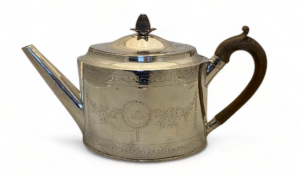
A George III Irish silver teapot by James Warner of Cork, circa 1795 | Warner became a Freeman of the Society of the Goldsmiths of Cork in 1799 and worked in the city until 1830
After Dublin Cork was the most significant centre in Ireland for silversmithing and (along with Limerick) it had its own guilds and rules although Dublin was to be the only authorised assay office, despite continuous lobbying by Cork for its own facility. A silversmith’s mark acted as his guarantee and customers accepted it. Up until about 1720 Cork silversmiths used marks based on the city’s arms, a three-masted ship between two towers, these marks were not struck by the local guilds but by the silversmiths themselves, with each having their own punches so there are many variations. Emblems representing town marks began to disappear in the early to mid-eighteenth century, possibly as in 1731 the Dublin Goldsmiths Company forbade the use of such ‘ornament’.
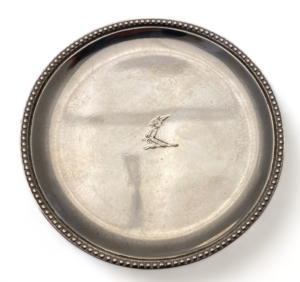
A small George III Irish Provincial silver wine funnel stand, Carden Terry, Cork, circa 1795 | Terry was born in 1742 and apprenticed in 1758, he first advertised his Cork silversmith business in 1764 and in 1768 he became a member of the Cork Goldsmiths Company. By 1770 he was advertising for an apprentice and in 1784 he had registered his business in Dublin
Along with the demise of the town mark, a purity mark was introduced in the early 1700s, silver made in Cork (and Limerick) took the word ‘STERLING’, occasionally also ‘STIRLING’ or ‘STARLING’, and even ‘DOLLAR’ – thought to have been used when an item was made from melted down Spanish dollars. Along with the use of the maker’s mark this system worked satisfactorily for both Cork silversmiths and their customers.
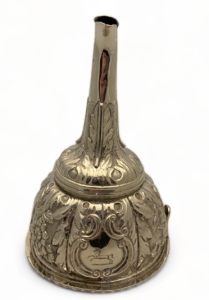
A 19th century Irish repousse silver wine funnel, probably Edward Power of Dublin, circa 1830 | Power is associated with the Dublin silversmith, solicitor and author, Edward Twycross (1803-1852) and silver produced by Power was frequently retailed by Twycross from his business at Fownes Street, and later at Dame Street, Dublin
In the early 18th century increasing quantities of provincial silver were being sent to Dublin for assay, however, the situation became more complicated in 1730 following the passing of the Irish Act which imposed a duty of 6d per ounce on all gold and silver wrought in Ireland. To prove the duty had been paid a mark, the figure of Hibernia, had to be struck by the Dublin assay office on all pieces. Henceforth making and selling silverware without this mark was a serious offence, which paradoxically had an unexpected effect in that the silversmiths of Cork decided not to send their goods to Dublin. A ledger of assay records from the Dublin office shows that from 1745-1748 not a single package of silver was received from Cork. Interestingly, despite the clear evidence of law flouting the Dublin Company seemingly had little in the way of either resources or energy to bring about prosecutions.
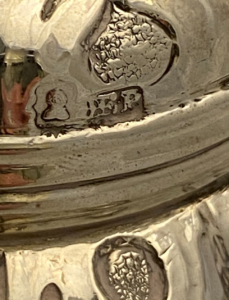
The marks from the silver wine funnel
In 1748 an Act of Parliament (passed in 1783) finally brought many of the silversmiths working in the provinces to order, they were obliged to officially register at the Dublin Assay Office and their goods had to be assayed and hallmarked there. The fine for not complying was £100, equivalent to £18,000 today, for each individual offence. Enforcement brought provincial silversmiths into line with those in Dublin although provincial marks were still used by a few, and in 1807 a Statute required the additional stamp of the King’s Head Duty mark on Irish silver, and with this the use of provincial marks was effectively quashed.
